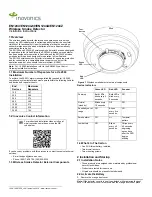
10.24.16 06755A_v6 © Inovonics, 2016 - www.inovonics.com
3
3.
Fit the detector inside the base by aligning it over the base and turning
it in a clockwise direction until it clicks into place.
4.
Refer to section 3, “Test the Wireless Smoke Detector” to test the
wireless smoke detector.
3 Test the Wireless Smoke Detector
There are two ways to test the wireless smoke detector sensor. The system
test should be performed every week; the smoke test should be performed
at least once a year.
The wireless smoke detector should also be tested after initial registration,
as well as each time the smoke chamber is cleaned or the batteries are
replaced.
3.1 System Test
1.
Use a small screwdriver or Allen key with maximum diameter of 0.18” to
push and hold the recessed test button for a minimum of five seconds.
Figure 4
Press and hold the recessed test button
2.
Ensure the sounder activates, the red LED lights briefly, and the control
panel, serial receiver or network coordinator receives a test signal,
followed a few seconds later by a restoral.
3.2 Smoke Test
Caution:
Performing a smoke test will transmit an alarm signal.
1.
Use aerosol simulated smoke, such as ESL Smoke! In a Can® (ESL
Part No. SM-200) to perform the smoke test.
• You can also perform a smoke test by holding a smoldering punk stick
or cotton wick at the side of the detector and gently blow smoke
through the detector until it alarms.
2.
Ensure the sounder activates, the red LED lights briefly, and the control
panel, serial receiver or network coordinator receives an alarm,
followed a few seconds later by a restoral.
4 Clean the Wireless Smoke Detector
1.
Disable the zone or system to prevent any unwanted alarms.
2.
Turn the detector counter-clockwise and remove from mounting base.
3.
Remove the battery from the unit.
4.
To ensure complete power down, wait 20 seconds.
5.
Turn the detector cover counter-clockwise and remove.
6.
Lift the smoke sensor to remove.
Figure 5
Remove the detector cover and smoke sensor
7.
Remove any dust or debris from the detector cover, smoke sensor, and
all other chamber sections using a vacuum or canned air.
8.
Align the arrows on the detector cover with the line on the smoke
detector and press down firmly until it is fully seated.
9.
Place the detector cover over the smoke sensor and turn clockwise until
it snaps into place.
10.
Reinstall the battery, noting proper orientation.
• The red and green LEDs will flash once every five seconds for
approximately 20 seconds until the power-up cycle is complete.
11.
Reinstall the detector and test per section 3, “Test the Wireless Smoke
Detector” on page 3.
Caution:
If this procedure is not followed, the detector may indicate
maintenance trouble after the power-up sequence is complete. In this case,
remove the battery for 20 seconds and reinstall.
5 Replace the Battery
To replace the battery:
1.
Twist the wireless smoke detector counterclockwise and remove it from
the mountain base.
2.
Remove the battery, properly disposing of it.
3.
To ensure the proper power-down sequence, wait at least 20 seconds
before installing the new battery.
4.
Following the polarity diagram inside the battery compartment, install
the new 3-volt CR123A lithium battery.
5.
Reinstall the detector onto the mounting base, and turn it clockwise to
lock it into place.
6.
Ensure the green LED is blinking about once every 10 seconds to
indicate normal operation.
7.
Test the smoke detector as described in section 3, “Test the Wireless
Smoke Detector”.
6 Television and Radio Interference
This equipment has been tested and found to comply with the limits for a
Class B digital device, pursuant to Part 15 of the FCC Rules. These limits
are designed to provide reasonable protection against harmful interference
in a residential installation. This equipment generates, uses and can
radiate radio frequency energy and, if not installed and used in accordance
with the instructions, may cause harmful interference to radio
communications. However, there is no guarantee that interference will not
occur in a particular installation. If this equipment does cause harmful
interference to radio or television reception, which can be determined by
turning the equipment off and on, the user is encouraged to try to correct
the interference by one or more of the following measures:
• Increase the separation between the equipment and receiver.
• Consult the dealer or an experienced radio/TV technician for help.
Changes or modifications not expressly approved by the party responsible
for compliance could void the user's authority to operate the equipment.
7 FCC Part 15 and Industry Canada Compliance
This device complies with part 15 of the FCC Rules and Industry Canada
license-exempt RSS standard(s). Operation is subject to the following two
conditions: (1) this device may not cause interference, and (2) this device
must accept any interference, including interference that may cause
undesired operation of the device.
Le présent appareil est conforme aux CNR d'Industrie Canada applicables
aux appareils radio exempts de licence. L'exploitation est autorisée aux
deux conditions suivantes : (1) l'appareil ne doit pas produire de brouillage,
et (2) l'utilisateur de l'appareil doit accepter tout brouillage radioélectrique
subi, même si le brouillage est susceptible d'en compromettre le
fonctionnement.
Test
button
Press button
with a tool of
0.18” diameter
or less
Detector
cover
Smoke
sensor




